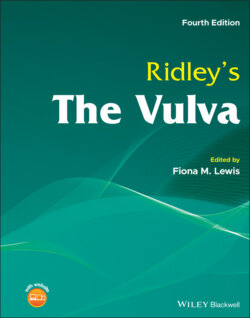Читать книгу Ridley's The Vulva - Группа авторов - Страница 22
Carnegie stage 9
ОглавлениеThe neural plate and the longitudinal neural ridges develop. The embryo flexes to accommodate the neural tube (Figures 1.5a–c) and in so doing reorients the primitive embryonic tissues and their relationship to each other. The endoderm of the dorsal part of the yolk sac is drawn into the ventral concavity of the embryo and is subdivided into foregut, midgut, and hindgut (Figure 1.6a,b). The hindgut appears about day 20 and is enclosed within the tail fold of the embryo. In this situation, the hindgut lies caudal to the rostral limit of the allantoic diverticulum and dorsal to the cloacal membrane. The mesoderm in the mid‐embryo region is divided into paraxial (surrounding the neural tube), lateral, and intermediate mesoderm. The intermediate mesoderm lies ventrally and lateral to the paraxial mesoderm, and differentiates medially into the gonadal ridge and laterally into the mesonephric region. The intermediate mesoderm at the rostral limit of the allantoic diverticulum extends dorsally and then caudally, in line with the curvature of the tail fold, dividing the hindgut into ventral and dorsal parts. As this division proceeds, the two parts of the hindgut remain in continuity with each other caudal to the advancing mesoderm of the urorectal septum. The caudal end of the hindgut is lined with endoderm and is known as the cloaca. On the ventral aspect of the cloaca there is a membrane which separates the endoderm from the surface ectoderm, the cloacal membrane. As development continues, a mesenchymal septum, the urogenital septum, migrates caudally (Figures 1.7a–c).
Figure 1.3 (a) The floor of the amniotic cavity, the dorsal surface of the bilaminar embryonic disc, revealing the primitive streak and notochord. (b) Intraembryonic mesoderm, generated by the primitive streak and interposed between the floor of the amniotic cavity and roof of the yolk sac, converts the bilaminar embryonic disc into a trilaminar disc. The buccopharyngeal and cloacal membranes remain bilaminar.
Figure 1.4 Migration of primordial germ cells into the genital ridge from the body stalk.
Figure 1.5 (a) As the neural tube is enclosed within the intraembryonic mesoderm, it lengthens and expands rostrally, causing a dorsal convexity and ventral concavity. (b) Further growth of the neural tube increases this curvature in the longitudinal plane (c) with the eventual formation of the head and tail folds.
Figure 1.6 (a) Midline section of the embryo after formation of the head and tail folds. (b) A transverse section of the mid‐embryo region after formation of the lateral folds.
